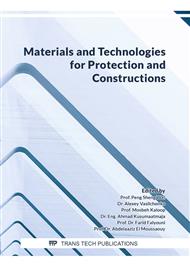[1]
Y. Li, C. He, J. Li, Z. Wang, D. Wu, G. Xu: A novel approach to improve the microstructure and mechanical properties of Al-Mg-Si aluminum alloys during twin-roll casting, Metals 13,1713(2020).
DOI: 10.3390/ma13071713
Google Scholar
[2]
R. Cook, P. G. Groock, P. M. Thomas, D. V. Edmonds, J. D. Hunt: Development of the twin-roll casting process, J. Mater. Process. Technol. 55(2) (1995) 76-84.
DOI: 10.1016/0924-0136(95)01788-7
Google Scholar
[3]
S.Hamers, D.Smith, C.Romanowski, G.Yildizbayrak, B.Taraglio, Twin roll casting of aluminum at 2.5mm gauge. Production experience and process improvement, Light Met. (1999)931-937.
Google Scholar
[4]
P.Y. Menet, R.Cayol, J.Moriceau, Pechiney Jumbo 3CM TM, start-up of the Neu-Brisach thin strip caster, Light Met. (1997) 753-756.
Google Scholar
[5]
O.Daland, A.B. Espedal, M.L. Nedreberg, I.Alvestad, Thin gage twin-roll casting, process capabilities and product quality, Light Met. (1997) 74.8-752.
DOI: 10.1007/978-3-319-48228-6_125
Google Scholar
[6]
T. Haga, M. Tsuchida, H. Sakata, H. Watari, S. Nishida: Globular Crystals in the Center of Roll Cast Aluminum Alloy Strips, Materials Science Forum, 1007(2020)34-40.
DOI: 10.4028/www.scientific.net/msf.1007.34
Google Scholar
[7]
T. Haga, High Speed Roll Caster for Aluminum Alloy, Metals 2021, 11(3), 520; https://doi.org/10.3390/met11030520.
DOI: 10.3390/met11030520
Google Scholar
[8]
T. Haga, K. Takahashi, M. Ikawa: A vertical type twin roll caster for aluminum alloy strip, J. Mater. Process Technol. 140 (2003) 610-615.
DOI: 10.1016/s0924-0136(03)00835-5
Google Scholar
[9]
T. Haga, Development of a twin roll caster for light metals, J. Achiev. Mater. Manuf. Eng. 43(2010) 393-402.
Google Scholar
[10]
M. S. Kim, Y. Arai, Y. Hori, S. Kumai: Formation of internal crack in high-speed twin-roll cast 6022 aluminum alloy strip, Mater. Trans. 51(2010), 1854-1860.
DOI: 10.2320/matertrans.l-m2010818
Google Scholar
[11]
M. S. Kim, H. W Kim, S. H. Kim, S. Kumai, Role of roll separating force in high-speed twin-roll casting of aluminum alloys, Metals 2019, 9(6), 64.8; https://doi.org/10.3390/met906064.8.
DOI: 10.3390/met9060645
Google Scholar
[12]
M. Sugiyama, T. Fukusako, A. Sato: Direct-rolling of molten pure aluminum, J. Japan Inst.Met.Mater. 32(1968), 731-735.
DOI: 10.2320/jinstmet1952.32.8_731
Google Scholar



